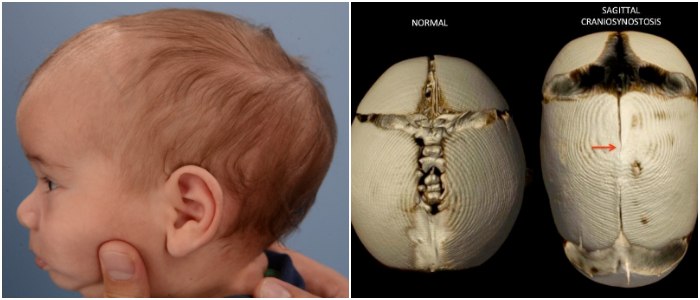Refers to a disorder characterized by a flattening of the skull’s back, which mostly affects infants.
Brachycephaly, which is a form of Flat Head Syndrome, is a condition that consists of a flattening in the spot at the back of a baby’s skull.
Some people consider it a manifestation of a Congenital Ossification of Sutures (Craniosynostosis). It features the premature closing of both coronal sutures of the baby’s skull.
Brachycephaly entails a noticeable reduction of the calvarial growth in the anterior-posterior plane, as well as a potential enhancement in the biparietal growth.
This disorder often appears along Plagiocephaly, and infants may develop Brachycephaly when they’re just a few months old.
When babies suffer from Brachycephaly, their heads will gradually show increased width, their ears seem like they’re getting pushed outwards, and sometimes, a slight bulging on the forehead might appear.
In most cases, this condition is not a cause for any significant concern, as it doesn’t have any effect on the brain and the shape of the head may improve in time.
Most usual features include an abnormally high ratio of maximal biparietal to fronto-occipital distance, a flattened occiput, and a prominent forehead.
Healthcare providers can usually diagnose Severe Brachycephaly at birth, but milder forms of this disorder may manifest after some time.
Causes
Brachycephaly occurs when the natural growth of the baby’s head meets pressure that inhibits that growth.
During the early days of an infant, the skull is still soft enough soft enough to get molded by external pressure.
And these external forces are more than capable of affecting the shape of the skull.
Still, this application of this pressure can happen either before the child is born, while the baby is still inside the womb; or exposure to flat surfaces for a remarkable amount of time after the kid is born.
More often than not, the causes of Brachycephaly are mostly congenital, and while they can vary, people can narrow them to the following factors:
The pressure during sleep: given how soft and pliable is the skull of a baby; such little children can develop this condition if they get used to sleeping in the very same position every night.
Medical experts often recommend parents not to place their babies on the back for them to sleep. It’s better for the children if they sleep in a supine position.
Large head size: some children may develop a higher sized head, in such cases, the babies’ muscles might not let them move the head properly, which could leave them in a position that leads to the development of this condition.
Prenatal and molding during birth: another factor that could induce Brachycephaly is an unusual positioning in the womb or an abnormal descent into the birth canal.
Low Level of Amniotic Fluid: it occurs when the mother’s amniotic sac doesn’t contain enough fluid, which results in less cushioning for the baby or babies.
When such thing happens, the baby’s bones (which includes the skull) are more susceptible to external pressure.
Brachycephaly Symptoms
When left untreated, both moderate and severe Brachycephaly can produce several health issues, such as the ones listed below:
- Astigmatism
- Delayed development
- Eating difficulties
- Learning difficulties
- Speaking difficulties
- Loss of vision
- Risk of hearing loss
- Mandibular Joint Dysfunction
- Scoliosis Seizure
Most of these issues are related to the way Brachycephaly affects the structure of the skull. But none of them negatively impacts the intelligence of the child.
However, some complications such as seizures can become a potential danger to the well-being of the baby, which is why Doctors recommend treating the child as soon as possible.
Brachycephaly Treatment
If the condition is still in its early stages, then there are several available natural ways to deal with Brachycephaly.
The most typical natural ways to treat babies who suffer from this disorder are repositioning and tummy time.
When feeding or carrying the baby, parents can try to alternate on which side they often hold the child. Keeping the infant mobile will prevent them from adopting a position that could worsen the issue.
Tummy time consists of giving the baby time during the day to play on their front, encouraging the child to try new positions during play time.
Later at night, parents should get the infant to sleep in a supine position.
Medical experts can also recommend a series of products such as helmets, cushions, and pillows, all specially made for babies that suffer from this condition.
In fact, several people regard helmet therapy as one of best treatments for Brachycephaly.




